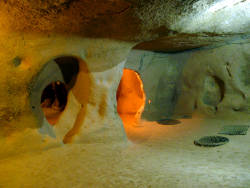Özkonak Yeralti Şehri
Özkonak Underground City
Useful Information
| Location: |
In Özkonak, 14 km north of Avanos.
(38.806565, 34.840259) |
| Open: |
OCT to 14-APR Tue-Sun 8-17. 15-APR to SEP Tue-Sun 9-19. [2020] |
| Fee: |
Adults TRL 25. [2020] |
| Classification: |
 Underground City Underground City
|
| Light: |
 Incandescent Incandescent
|
| Dimension: | |
| Guided tours: | D=2h |
| Photography: | |
| Accessibility: | no |
| Bibliography: | |
| Address: | Özkonak Yeraltı Şehri Yolu, 50500 Avanos/Nevşehir, Tel: +90-384-513-5168. |
| As far as we know this information was accurate when it was published (see years in brackets), but may have changed since then. Please check rates and details directly with the companies in question if you need more recent info. |
|
History
| 400 BC | excavations started. |
| 1972 | discovered by a farmer. |
| 1990 | opened to the public. |
Description


Özkonak Yeralti Şehri (underground city of Özkonak) is named after the village where it is located. There is only a single main passage in every level, and the whole city is built along this central tunnel. Özkonak has ten levels, the five uppermost levels were developed and are open to the public. The city has water wells, churches, barns, sleeping chambers, storage rooms, toilets, a kitchen, and a winery. This is quite common and can be found at all underground cities.
Özkonak has two extraordinary details. Common among the underground cities are huge millstone doors, which were rolled into narrow sections of the passage and wedged from the inside. But here at Özkonak, they have a special feature: in front of the millstone doors on the ceiling are small holes. They are connected to the tunnel above, and were used to pour hot oil on the enemy or to spear them. Long, narrow connections, about 5 cm in diameter, connect the different levels and neighbouring chambers. They are interpreted as ventilation ducts and for communication. All those small connections are unique and have so far not been found at other underground cities in Cappadocia.
The underground city was discovered in 1972 by the Imam of the village, while he was irrigating a field. He noticed that the irrigation water seemed to drain somewhere into the ground. A little research for the whereabouts revealed a collapsed underground passage.
The village and its surrounding are full of caves and cave houses. Two valleys, which are dry most of the year, have hundreds of chambers cut into the walls. A hill close to the underground city is full of graves, which were dug into the rock. And a few kilometers to the south is the monastery Belha Manastırı, which was inhabited between the 6th and 10th century.
- See also
 Search DuckDuckGo for "Özkonak Underground City"
Search DuckDuckGo for "Özkonak Underground City" Google Earth Placemark
Google Earth Placemark Özkonak Underground City - Wikipedia (visited: 21-OCT-2020)
Özkonak Underground City - Wikipedia (visited: 21-OCT-2020) Özkonak Underground City - Atlas Obscura (visited: 21-OCT-2020)
Özkonak Underground City - Atlas Obscura (visited: 21-OCT-2020) Ozkonak (visited: 21-OCT-2020)
Ozkonak (visited: 21-OCT-2020) Ozkonak Underground City (visited: 21-OCT-2020)
Ozkonak Underground City (visited: 21-OCT-2020) Özkonak Underground City, Cappadocia, Turkey (visited: 21-OCT-2020)
Özkonak Underground City, Cappadocia, Turkey (visited: 21-OCT-2020)
 Index
Index Topics
Topics Hierarchical
Hierarchical Countries
Countries Maps
Maps